[orc]While the overall revenues of Railways have increased in the last 10 years barring 2016-17, the growth rate of revenues has fallen in the last few years. Here is a look at the numbers for the last 10 years.
Railways are the lifeline of India’s public transport and also contribute significantly to the economy. A major share of the passenger traffic as well as transportation of goods & freight across the country is of the Railways.
The revenue earned by Indian railways is a key component of non-tax revenue of India and is used to meet the revenue expenditure of the railways along with funding infrastructure development and other capital investments of the Railways.
Therefore, a continuous increase in revenue of railways is important to ensure that the growing expenditure & investment needs are met. That will also ensure that these investment needs do not become a burden on India’s budget. In this story we explore the trends in railway revenue over the past decade.
The growth rate of overall Railway Revenue has slowed down
Factly had filed an RTI application and received information in regard to the various sources of railway revenue for the last 10 years. As per this information, the provisional revenue for 2018-19 is ₹ 190.57 thousand crores (1.9 lakh crores). This is an increase over the previous year where the actual total revenue as per the RTI information was ₹178.9 thousand crores.
At the beginning of the decade i.e. 2009-10, the revenue of the railways was ₹ 89.36 thousand crores. The overall annual revenue has increased every year barring 2016-17, when it was less than the revenue of 2015-16 by about ₹ 2400 crores.
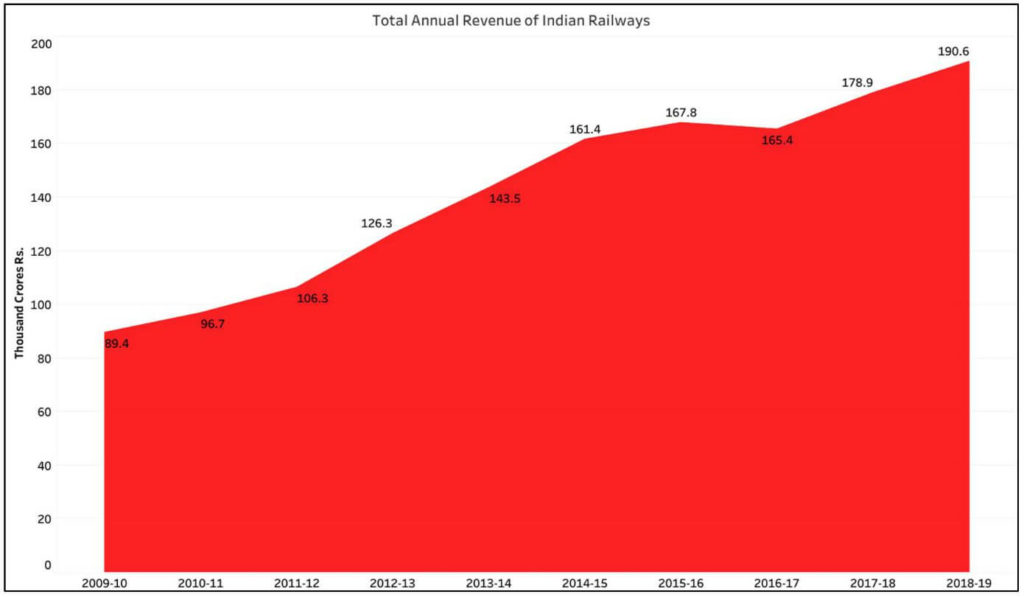
Rate of growth of Railway revenues has slowed down over recent years
While, the annual revenues have increased during 9 of the last 10 years, the rate of growth has reduced over the past few years. For the year 2010-11, the annual revenue of railways has increased by 8.17% over the previous year. In the subsequent years the rate of growth was more than the earlier years with 2012-13 recording an annual growth rate of 18.87%.
The next two years, all though the annual growth rate was less, it was still in double digit figures. In the last four years, however, the annual growth rate of railway revenues has only been in single digit. As highlighted earlier, there was a negative growth in 2016-17 when the revenues shrunk by 1.46%.
The provisional annual growth rate for 2018-19 is estimated at 6.52% which is less than the previous year (2017-18)’s growth rate of 8.17%.
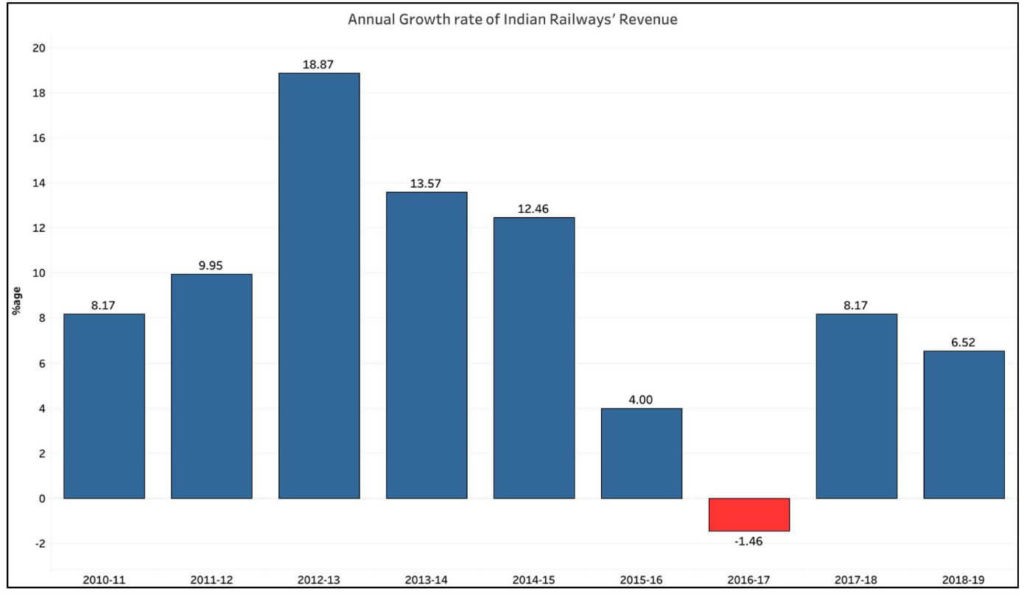
Revenues from Goods forms the largest share of Railway revenues
The revenue from transportation of goods average out to around 65% of the total railway revenue, for the last decade. With such a sizeable chunk of the total revenue, any variance in the revenue earned from goods had a direct impact on the trends of overall revenue.
For the year 2018-19, the provisional revenue for Goods was ₹127.43 thousand crores, which makes up to 66.87% of the total revenue. At the beginning of the decade in 2009-10, the revenue from goods was ₹ 58.5 thousand crores.
Apart from the blip in 2016-17, where the revenue earned was ₹ 4.87 thousand crores less than the previous year, the annual revenue from goods did increase every year over the last decade.
Income from passengers forms the second highest source of revenue for the railways. In 2009-10, the revenue earned from passengers traveling by Indian Railways was ₹ 23.48 thousand crores. The annual revenues from this segment witnesses an incremental increase every year and by 2018-19, the provisional revenue earned through passenger traffic is ₹ 51.06 thousand crores.
The revenues earned through other sources like sundry services, miscellaneous receipts and other coaching services are marginal compared to the earlier two sources. The total revenue earned from these three services in 2018-19 is ₹ 12.07 thousand crores. There is a whole list of heads that are classified as sundry services. These include rents, lease amounts of railway property, parking charges in railway stations, sale proceeds of unclaimed or damaged goods etc.
While the revenue earned from other coaching services and sundry services has been largely incremental every year, the revenue from Misc. receipts have tapered off over recent years.
The year 2016-17, marks a standout year fir sundry services, wherein Indian railways earned ₹ 10.37 thousand crores.
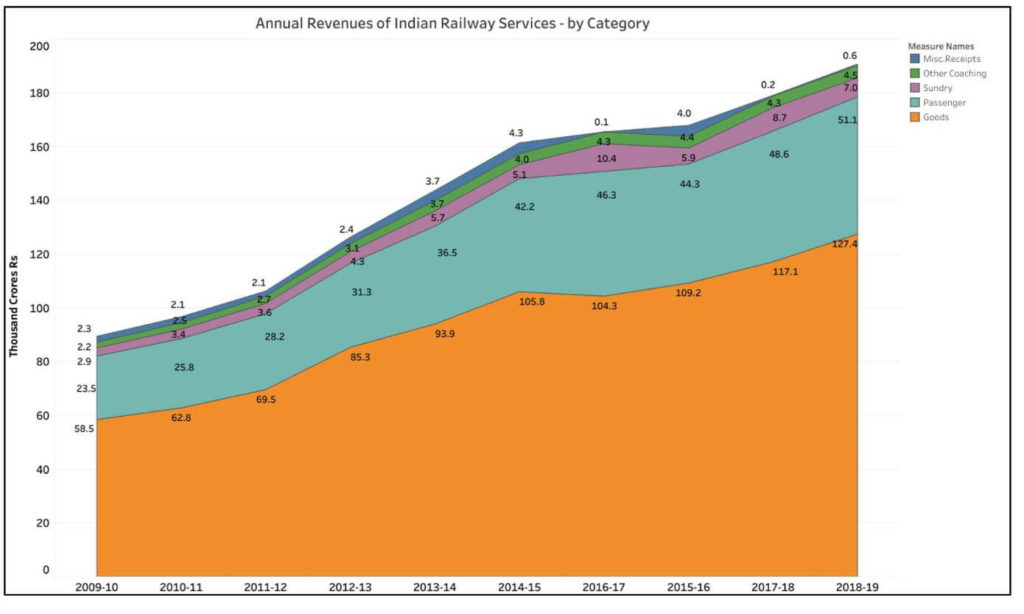
Growth rate of revenue from goods largely influences the overall revenue growth
As highlighted earlier, revenue from goods forms a major portion of the overall revenue earned by Indian Railways. The inconsistency in the growth rates observed over the decade in the overall revenues is largely contributed by the inconsistencies in the growth rates of revenue earned from goods.
The four-year period during 2011-15 has recorded growth rates in revenue through goods services in double digits with 10.67%, 22.60%, 10.14% and 12.66% for 2011-12, 2012-13, 2013-14 and 2014-15 respectively.
This period was followed by low growth rate of 3.23% and negative growth of -4.46% in subsequent years. The growth rate in revenues through Goods services has fared better over the last two years with 12.9% and 8.87% in 2017-18 and 2018-19 respectively.
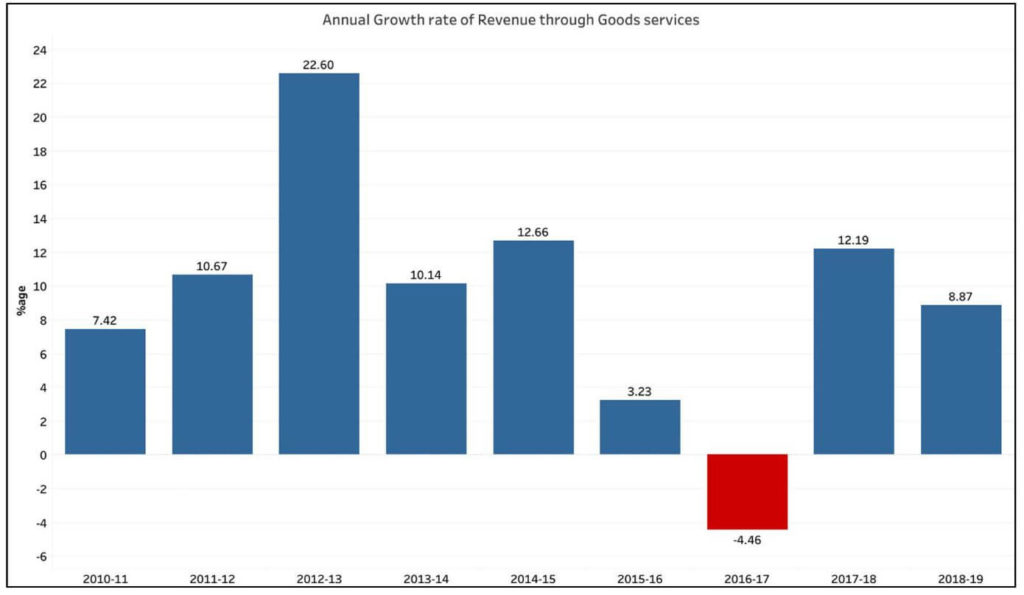
Lower growth rates in revenue through Passenger services over past 4 years
Unlike revenue earned through Goods services, the annual revenue earned through Passenger services increased every year. However, the rate of growth has slowed down in the last four years.
During the initial years of this decade the growth rate was 9.81% and 9.51% for 2010-11 and 2011-12 respectively. During the next three years, the revenues earned through passenger services have recorded a double-digit growth year on year with 10.89%, 16.63% and 15.49% respectively. However, after these high growth years for revenues earned through passenger services, the growth rates have fallen to single digit numbers over the last few years. The growth rates for the last four years i.e. during the period 2015-19 were 4.96%, 4.51%, 5.11% and 4.98% respectively as noted in the chart below.
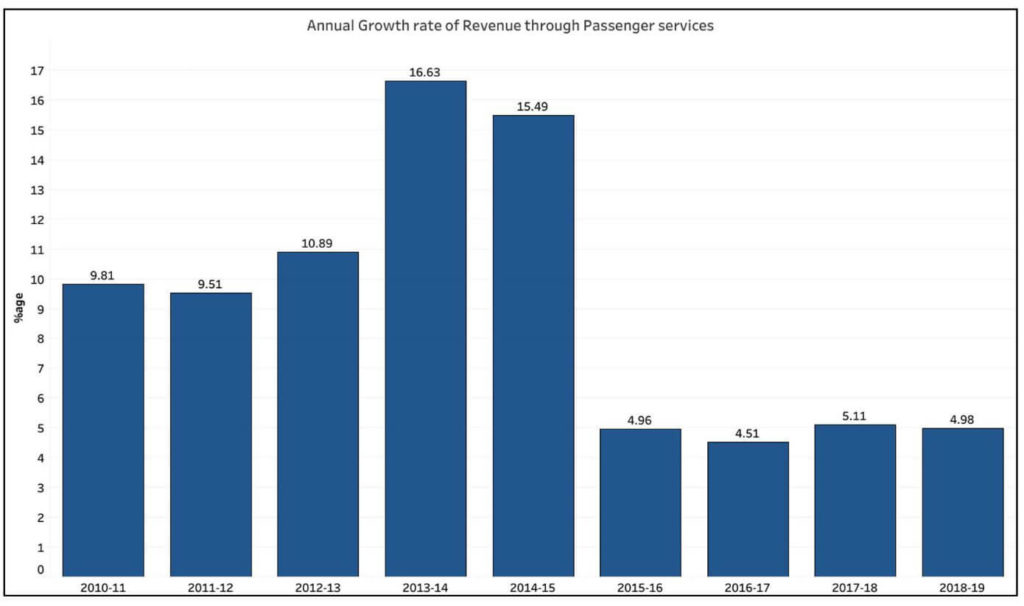
Meeting increased expenditure year on year is a challenge
A look at railway budget over the years reveals that a major portion of the revenue earned by the railways goes into meeting the working expenses.
The Railway budget for 2019-20 estimates the total revenues at ₹ 216.93 thousand crores. Of this, the amount to be spent on working expenses is estimated at ₹ 205.5 thousand crores. A further 2.4 thousand crores are estimated for miscellaneous expenditure.
Furthermore, in her budget speech for 2019-20, the Minister of Finance, Mrs. Nirmala Seetharaman has estimated that around ₹ 50 Lakh crores would need to be invested in Railway infrastructure between 2018-2030. It is further estimated that the capital expenditure every year is going to be around ₹ 1.5 to ₹ 1.6 lakh crores
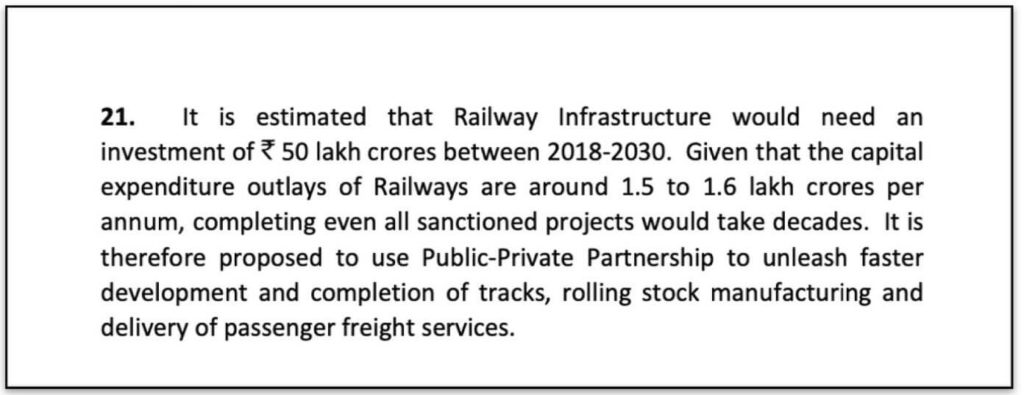
Although a Public-Private partnership is proposed, currently a major burden of this capital outlay falls on the government. In this context, the lower growth rate in railway revenues is a cause of concern as it may lead to additional burden with government having to cough up money for railway infrastructure development. With a high operational ratio of around 95%, Indian railways is treading a very fine line in managing its operational expenses with the revenues earned, let alone funding capital investments with its revenues. Hence, the need to increase the revenues and reduce the operational ratio are imperative.
Featured Image: Growth of Railway revenues in India



2 Comments
Pingback: Growth of Railway revenues falls in the last few years - Fact Checking Tools | Factbase.us
It looks very good, I always have to ask, thank you for your information